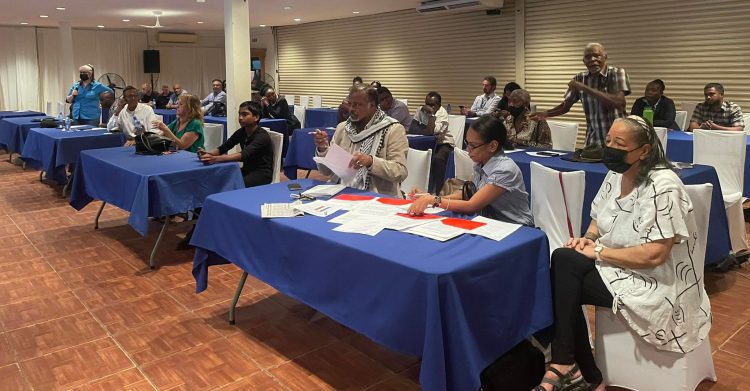Despite its efforts to assure that the operation of a radioactive (RA) source storage and calibration would cause no harm, a group of residents of Houston and nearby communities yesterday adamantly told oil and gas company, Schlumberger Guyana Inc that they do not want the operation in their community.
Since having been injuncted last year by the High Court from proceeding with the facility as there were breaches of the environmental laws, Schlumberger is seeking to renew its efforts for approval for its operations. This new effort will pose a major challenge to the Environmental Protection Agency (EPA) which will have to take account of the court ruling and the strenuous objections by residents.


Residents let it be known to the company that they are not pleased nor convinced that the explanations given are sound. They said Schlumberger’s (which has rebranded itself as SLB globally) objective is making money and the explanations given is intended to make the company “look good.”
The moderator for the meeting at times found it difficult to manage the strong views of the residents as they spoke over those from the company who attempted to address their concerns.
The objections were registered during a public stakeholder engagement held at Parc Rayne, Houston, by IMEX Inc, which has been conducting consultations on behalf of Schlumberger.
“I want to tell you, we the residents say X on the operations – we do not want you here,” an agitated resident announced during the question and answer segment. His announcement was greeted by cheers from the dozen residents gathered.
On the sidelines of the event, Schlumberger’s in house attorney, Kyle Prescod, explained to Stabroek News that the engagement was not specifically scheduled for consultations on the new application. He explained that it was a part of the enactment of the Environmental Assessment Management Plan (EAMP), which was approved in January by the EPA to educate the public. He noted that with the new application, which specifically deals with the operation and storage of the RA facility, it was an opportunity to engage the public though it was not a requirement.
The company, days after the court ruling, filed a new application with the EPA for the operation, storage, and calibration of radioactive chemicals at its Houston, East Bank Demerara location. The EPA has not said anything about this application.
At the engagement yesterday, Vanda Radzik, one of the applicants in the court order that granted an injunction against the operation, told the company that they were acting in contempt of the court order.
However, Prescod and others from the company refuted the comment and said that the specific operation has been ceased pending the application.
As he sought to explain further, Radzik loudly countered, “Contempt of Court… the injunction said no operation… Contempt of Court!”
Prescod, in an attempt to respond to Radzik’s statements, asserted that his company follows the law and the guidelines of the regulators in their operations. “The injunction is the law,” however, was Radzik’s response to the explanation.
Danuta Radzik, who was also an applicant in the court case and is a resident of Houston, said during the consultation that they are not convinced the operation is safe enough to be in their community. She pointed out that Schlumberger does not have squeaky clean safety records and from a simple Google search, one can find the number of violations and breaches the company has been fined for in the past.
“You safety record is not very good… it is not just in Guyana but other parts of the world you have been fined.”
Vanda Radzik interjected that the company has faced sanctions for health and safety violations, exposure to radioactive chemicals, and financial breaches, among others.
The Radziks also called out the company for not addressing this matter during the public engagement.
Meanwhile, former councillor of the Georgetown municipality Welton Clarke asked why the company did not consider an offshore location for such operations. He opined that it would have been a better option as there are no residential or public infrastructure out there. “Why Houston? Why not 50 miles or 30 miles away from here?”
Prescod, while entertaining questions from the media, sought to explain that a riverine community was suitable since it eliminated the dangers of road transportation. He stated that the pits for the storage of the RA materials are built taking into account proximity to the river. When the sources, which are battery size come into the country, it goes to the facility for storage in the pits. When it is required off shore it is taken out and calibrated into the tools and sent offshore.
James Dough Aifken, described as an expert in radioactive materials and a consultant to SLB, explained that that at no point is a radioactive source completely out and exposed. During the question and answer segment, he had said that the material is used for powering the drills for offshore exercises. He also stated that the sources are always protected by shields and if it is ever exposed, it is during drilling and even in that phase once exposed it is encapsulated and not dispersed.
It was disclosed that all unused sources are returned to their manufacturers no matter the country of their operations.
“Nothing will happen to the environment if it is accidentally released. They can stay there for a 100 years. They will not release because they have shields but believe me before a 100 years we will be back there to take it out and take them to a safe place. I can guarantee you that soon as we can access those pits, we will remove the source from the pits,” Aifken said in response to question from Rosh Khan. Khan had asked what plans are in place in the event the environment was exposed to the source.
He stated too that the sources are stored in several layers of protection making it difficult for exposure to occur. The expert noted that from all their tests so far, RA exposure from the inside wall indicates that it is at a safe level and with time and distance, the level of exposure was significantly reduced and they were not able to detect any harmful radiation.
However, the residents challenged the explanation by stating that the company was only trying to convince them in an effort to win over their approval for the project.
“You guys have too much experience for us whatever you say you expect us to accept it. It is not fair we don’t want you here,” one of the residents from the gathering said.
Prescod, nonetheless stated that even with no radiation monitoring body present in Guyana, they are operating under the guidelines of the International Atomic Energy Agency. He stated that this has been their approach in all countries that do not have a monitoring framework in place.
EIA
Asked if the agency is prepared to conduct an Environment Impact Assessment (EIA), Prescod said the company is “in the hands of the regulators and whatever the regulators say is required we will have to respect and adhere to.”
He added that the EPA will have to determine whether the project requires an EIA or an updated and developed EAMP. Nonetheless, he stated that the company has been executing their own assessment and monitoring of the facility to ensure that they are compliant with all international operating guidelines.
During the period of operation, the attorney stated too that the EPA has been conducting their own monitoring and evaluation of the facility.
Justice Nareshwar Harnanan back in December had ruled that the EPA breached its statutory duty by issuing environmental permits to Schlumberger-Guyana Inc and waiving the requirement for an EIA for the construction of a radioactive chemical facility. The judge noted that the EPA had not given reasons for its decision. As a result, Justice Harnanan ordered the quashing of the environmental permit issued by the EPA on June 9, 2021, in favour of Schlumberger to permit it to construct a radioactive substances and materials storage and calibration facility at Lot 1, Area X, Houston, on the East Bank of Demerara. The High Court judge also declared that the decision of the EPA to not conduct an environmental impact assessment into the effects of the construction of the facility was illegal, ultra vires, unreasonable, and irrational, for breaching the Environmental Protection Act, Cap.20:05.
During arguments, the EPA said that permission was given for the construction of the facility and not for the operation of a radioactive substances and materials storage and calibration facility. However, the High Court Judge ruled that the operation and construction must not be viewed separately. In the court’s view, he said the EPA cannot treat the operation independent of the construction permit when it is a condition precedent to the functionality of the facility. The Radziks and Raphael Singh, via court filings, had said that they live near the radioactive facility, which is also in proximity to schools and places of worship. They contended that the EPA’s decision was made without any consultation with residents.
Against this background, they accused the EPA of having arbitrarily made the decision in breach of its statutory duty and contrary to natural justice. They said, too, that it was made in the absence of evidence, was unfair and asked that the Court so declare. They asked the High Court to declare the EPA’s decision waiving the requirement for an EIA as being among other things, unlawful and unreasonable.
On December 24th, 2022, the EPA said that it respected the outcome of the case. The environmental agency said it “acknowledges its error in this instance, and will adhere to the Honourable Court’s judgment.” It added: “The EPA wishes to make it clear that the judgment was not against the Agency’s decision to waive the requirement for an Environmental Impact Assessment (EIA), but rather our failure to publish in our statutory notice reasons/adequate reasons for the decision not requiring an EIA.” It noted that Justice Harnanan in his judgment stated: “That the EPA’s decision to waive the requirement of an Environmental Impact Assessment with respect to SGI’s application for environmental authorization for the construction of the said facility is in breach of the EPA’s statutory duty for failure to provide reasons for the waiver as mandated under section 11(2) of the Environmental Protection Act, Cap.20:05.”





